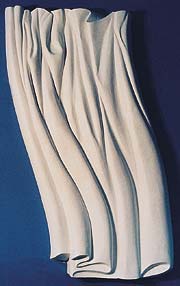Blowin' in the Wind
Harry Roseman, associate professor of art, has been spending a lot of time making curtains lately. But he isn't redecorating his living room. Roseman and his assistant Allison Paisley '98 are creating Curtain Wall, one of three works of art commissioned for the new International Air Terminal at New York's John Fitzgerald Kennedy International Airport, scheduled to open in 2001.
Stretching along 600 linear feet between plane and customs checkpoints, Roseman's sculpted wind-tossed curtains will greet arriving passengers as a blast of fresh air. As the dimension of the wall grows higher along the downward slope of the corridors, the sculpted drapery will grow in scale and emotion, becoming, in Roseman's words, "more dramatic, more baroque, more undulating," in the imaginary wind. The culmination of the piece, just prior to entry into customs and immigration, is an energetic pas-de-deux between air and fabric in which the wind runs away with the last sets of curtains.
Curtain Wall, which is to be completed and installed next spring, will comprise 21 distinct sculptures cast (with repeats) into 60 individual cream-colored curtains made of modified gypsum. The curtains will range in size from the smallest at 4 1/2' by 7' to the largest at 13' by 11', with one diagonal piece that measures 14' in length and 5' in height. In each of two corridors, segments will be mounted directly on a blue wall that faces windows.
Even in progress, the work is impressive; sculpted green Styrofoam-used to make the molds for the castings-mounted on Roseman's second-floor studio above Vassar's dining center convey both the scale and luxuriousness of the curtains to come.

Roseman reasoned that people arriving from other countries would identify with a familiar subject and feel welcomed.
That is, of course, if they notice the sculpture at all. While Roseman is striving to create a work of art that has meaning on many levels, he is realistic enough to wish that, at the very least, passers-by will simply take note of it's beauty. "I'm hoping that they won't ignore it. I'm hoping it's going to be kind of exhilarating and that they will be, in a sense, struck by it, beyond the associations that they might draw from it. I want them to go, 'oooooooh, this is something.' But a lot of people will just be worried about what's in their bags and having to go through all this bureaucracy," he said, with a laugh and a shrug of his shoulders.
Until Curtain Wall is installed at JFK, viewers can see another sample of Roseman's large-scale public art, completed in 1989: Subway Wall, 42' long and 7' high, is at the 60 Wall Street Subway Station in New York City.
